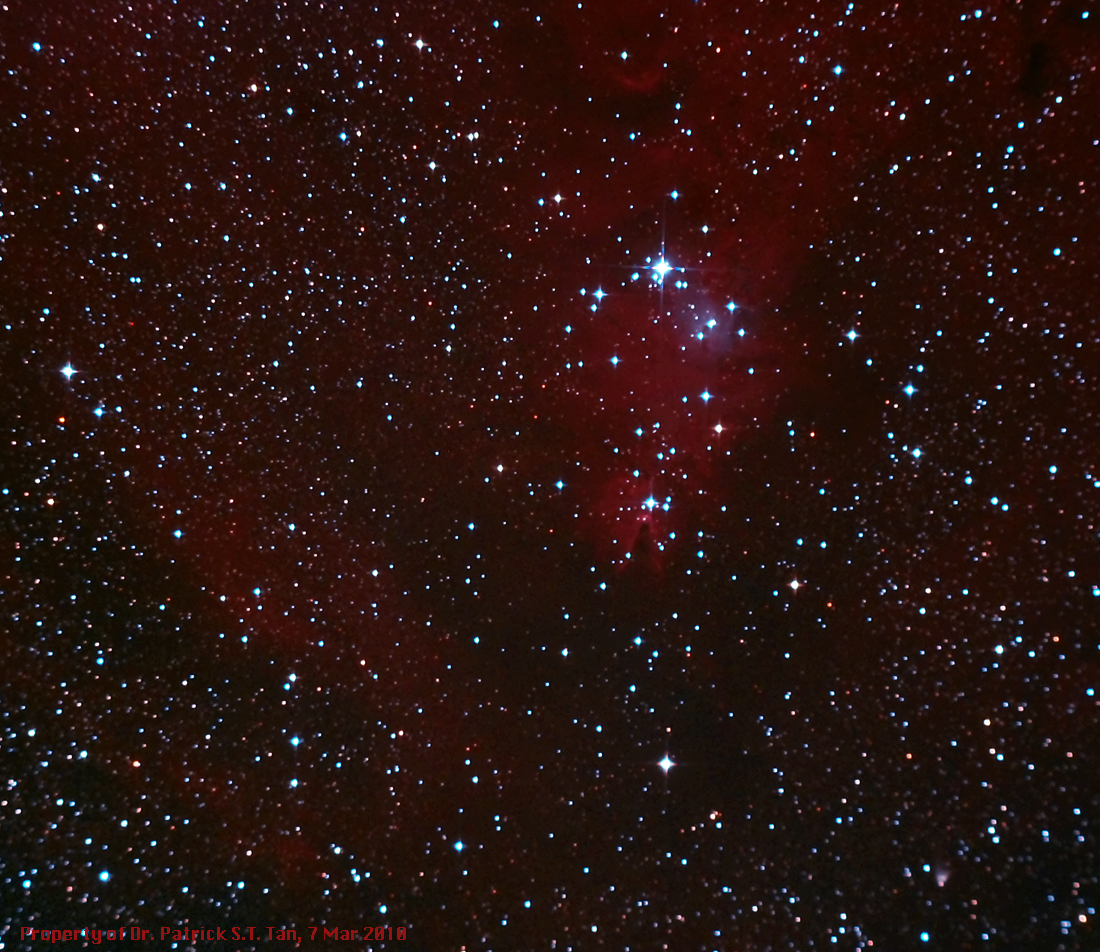
NGC 2264, Cone Nebula
Date: 07/03/10 Time: 2013hrs Location: Sunningwell Temperature: 2.7ºC Relative Humidity: 47%
Camera: Nikon D80 Scope: William Optics Z66 Apo Doublet at prime focus Mount: piggy-backed on Meade LX90 in equatorial mode Filter: Astronomik CLS (LPF broadband filter) Exposures: 6x10min, 1x7min, 1x6min, 1x3min ISO: 1600 F ratio: 5.9 Guidance: Autoguided
NGC 2264 is the star cluster around the central bright star of this picture, S or 15 Monocerotis. Two years ago when this constellation was in the same place in the sky, ideally suited for viewing from my balcony, I caught the Rosette Nebula, NGC2237 which is slightly below this target. This year, I've gone for the part of Monoceros which is extremely rich in deep sky objects, centred around the quadruple star system of 15 Monocerotis which gives rise to the mixed emission (red) and reflection (blue) nebula which you can see. The Cone nebula get its name from the cone shape of dark dust at the bottom of the red cloud. This nebula, although 2200 Light Years away, is actually in our own backyard, lying in the Orion arm of the Milky Way galaxy. It is a near neighbour comparatively speaking. Not visible in the photograph is another blue reflection nebula, IC 2169, which is actually situated around the bright energetic blue stars to the right of the dark dust gap on the right of the main red nebula. If you look carefully at the bottom right of the photo, you will see a white smudge shaped like a stubby comet with a fan-tail. This was a bonus to capture - Hubble's Variant Nebula, NGC 2261. It is a bipolar nebula formed by the emission of 2 gas streams from the young star R Monocerotis and is an example of a Herbig-Haro object - energy emitted when gas streaming from a star collides with the interstellar medium. The nebula varies because the star itself varies in magnitude between 9.3 and 14.0.
Now for the details of the capture - we enjoyed 4 days of stable high pressure coinciding with a weekend. This was what my brother Peter and I call 'the Magic Confluence!' It is the concurrence of good weather, clear skies, moon new or near-new, and a weekend so we can stay up late and not worry about work the following day! As it happens, this was taken on a Sunday, so I DID have to worry about work, but the timing of the constellation's apparition for my balcony was all pre-midnight. And best of all - the sports ground Tilsley Park is closed on weekends. Seeing was moderate-to-good, transparency was good, but there was much air-traffic. 9 exposures were stacked to make up a cumulative exposure of 76 minutes. One of the exposures was altered to remove an awful aircraft 'con-trail' and its under-fuselage red light, so this picture is no longer scientifically accurate. Stacking was by summation in Maxim DL, background light pollution was subtracted using a uniform colour mask sampled from a 100% 'dust-and-scratches' duplicate of the original frame, then the usual white and black point setting and midtone enhancement was carried out with Photoshop and one pass of Noise-Ninja to remove artefact and to smooth the background.
HOME PICTURES: Deep Sky PICTURES: Solar system PICTURES: Wide field